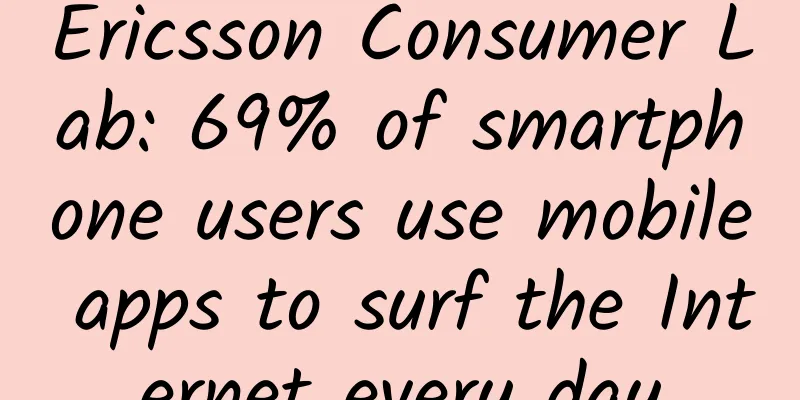Ericsson Consumer Lab: 69% of smartphone users use mobile apps to surf the Internet every day

|
On April 24, 2012, according to the report "Emerging Application Culture" by Ericsson Consumer Research Lab, in addition to the desire for better or faster Internet access, another major motivation for consumers to buy smartphones is the desire to connect to mobile applications. The report, released by Ericsson ConsumerLab after surveying high-growth markets such as Russia, India and Brazil, also shows that new and old smartphone users use apps to the same extent. In addition, 69% of smartphone users surveyed use mobile apps to access the Internet every day, and 20% use data-intensive services such as video, TV, maps or navigation applications every day. For consumers who recently purchased smartphones, the top ten most popular activities are: address check-in, map navigation or real-time traffic information, watching online TV, watching movies, playing online games, watching streaming videos, playing games on social networking sites, watching real-time news, using Twitter, and reading/writing blogs. For consumers, staying connected and having access to tools and services is crucial. For them, using a smartphone basically means using apps. However, there are some differences in the use of mobile apps by consumers in the three markets mentioned above. Compared with social media apps and games, smartphone users in India prefer to download personalized apps such as screen savers, live wallpapers/themes, and third-party browsers. Smartphone users in Russia pay more attention to practicality and tend to use apps that help with daily life, such as navigation maps, shopping comparisons, barcode scanning, translation, dictionaries, etc. Smartphone users in Brazil are accustomed to using various apps to enhance social interactions. Jasmeet Singh Sethi, Senior Expert at Ericsson ConsumerLab, says: “The emergence of app culture in these high-growth markets is very similar to the trends seen in the US and other developed countries. Mobile apps are no longer the preserve of the first players. While older smartphone users use apps more frequently than new users, new users are buying niche apps, such as dating services and price comparisons, as soon as they get their hands on a smartphone. New users use these niche apps almost as much as older users.” Compared with mature markets, high-growth markets show some differences in the use of apps. Two-fifths of users rarely or never visit official app markets, but download apps directly from third-party websites and forums. Nearly half of users first download apps to their PCs and then sync them to their smartphones to save data traffic and avoid exceeding data limits. In terms of daily usage of apps, 49% of respondents use apps for socializing, 39% for chatting, 31% for checking weather forecasts, 26% for reading news, 20% for maps, GPS and navigation, and 12% for checking timetables and traffic conditions. “These numbers show that consumers are interested in applications that can solve daily problems and interact with people, places and things in urban environments,” Sethi said. “We believe that smartphones and their applications will significantly change the lifestyles of residents in high-growth markets as they move into a connected society.” |
<<: Best examples of travel companies using Pinterest
>>: New marketing inspiration brought by image social media
Recommend
Vaginal discharge
The vagina is a very important reproductive organ...
Can auntie inject hyaluronic acid?
Hyaluronic acid is a very popular way to stay you...
Will I be irritable in the early stage of implantation?
After a woman's sperm and egg combine and the...
Female headache after sex
Couples' sexual intercourse headache refers t...
What are the traditional Chinese medicine formulas for irregular menstruation?
Do not underestimate the disease of irregular men...
The correct steps and methods for removing makeup
Girls usually pay more attention to makeup, becau...
Examples of successful pregnancy by eating black beans
Nowadays, many friends attach great importance to...
Do I need to dilute iodine when washing the vulva?
When women have gynecological inflammation, they ...
Recovery from episiotomy during childbirth
Many female friends who have given birth will hav...
How long does it take for the pelvic inflammation suppository to be absorbed?
Pelvic Inflammation Suppositories mainly have the...
What should you pay attention to and how to regulate yourself after an artificial abortion? The answer is this
Female friends who are preparing to have or have ...
Will infertility be listed as one of the three major diseases of mankind in the 21st century? Obesity is the direct cause?
Expert in this article: Wang Yi, attending physic...
How long can you live after chemotherapy for ovarian cancer?
Ovarian cancer is a common gynecological tumor di...
What causes painful urination in women?
What causes stinging pain when women urinate? For...
Medical abortion at 4 weeks of pregnancy
Some women find themselves pregnant and do not wa...









